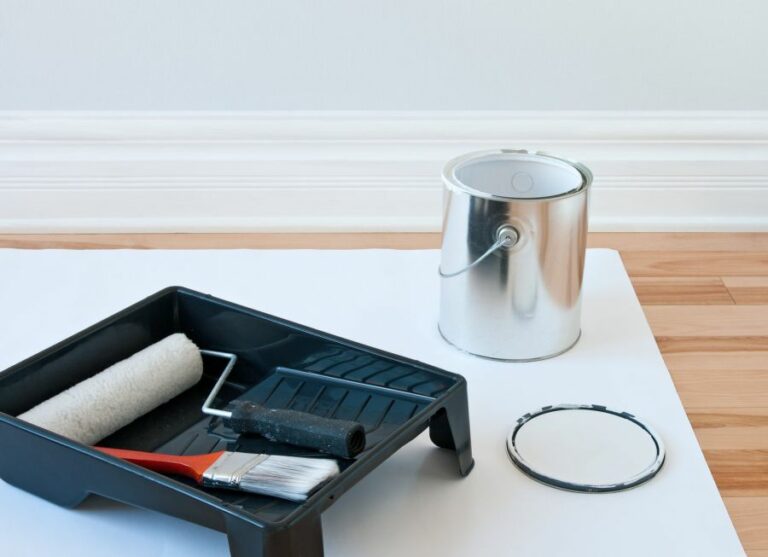Paint For Outdoor Resin Statues, 25 Things You Should Know
Painting or refreshing outdoor resin statues can be a daunting task but worry not. I’m here to guide you through the process, ensuring fantastic results. Having dealt with this topic extensively, I’m confident in my knowledge of the best paints and techniques to transform your resin statue into a visually appealing masterpiece. So, let’s dive into the world of paint for outdoor resin statues and make your garden sculptures both lasting and eye-catching.
Paint for outdoor resin statues:
The best types of paint for outdoor resin statues include acrylic, enamel, and spray paints specifically designed for outdoor applications or marked as UV-resistant. Before painting, clean, sand, and prime the statue’s surface for better adhesion. Apply paint evenly in thin layers using brushes or spray paint. Finally, seal the painted statue with a clear, UV-resistant outdoor sealant to protect it from weather and other elements.

Discover the world of paints specifically designed for outdoor resin statues and learn how to transform your garden ornaments into stunning works of art. Want to make your statues stand out in style? Read on for tips, tricks, and product recommendations that will elevate your outdoor space.
Contents
- 1 High-Quality Paint for Outdoor Resin Sculptures
- 2 Which Type of Paint is Suitable for Outdoor Resin Statues?
- 3 Is it Possible to Apply Paint on a Resin Statue?
- 4 What Type of Paint is Suitable for Application on Resin Figurines?
- 5 What is the Process for Sealing an Outdoor Resin Statue?
High-Quality Paint for Outdoor Resin Sculptures
Resin statues are popular for their durability and myriad design options, making them an excellent choice for outdoor garden decorations. However, over time, the paint can fade due to exposure to sunlight and other elements.
• Types of Paint Suitable for Outdoor Resin Statues
There are various types of paint available in the market, but not all are suitable for outdoor use or for resin statues. Here are some reliable, weather-resistant paints you can use for your outdoor resin statues:
– Acrylic Paint
Acrylic paint is a water-based paint that is quite popular for its quick drying abilities and ease of application. It is capable of adhering to a variety of surfaces, including resin.
The high pigmentation quality in acrylics ensures that they are resistant to fading from sunlight, making them suitable for outdoor use. Look for acrylic paints designed specifically for outdoor applications or those marked as UV-resistant.
– Enamel Paint
Enamel paint is an oil-based paint that provides a glossy, sleek finish to the surface. It is a durable option for outdoor resin statues due to its resistance to water, rust, and fading. Enamel paints are available in an array of colors and can be used for detailing work after applying a base coat from acrylic or other paints.
– Spray Paint
Spray paint is a convenient solution for covering large surfaces of your resin statue. It provides a smooth, even coating, and many brands offer options explicitly designed for outdoor use. Look for spray paint options that are designed for plastic or flexible surfaces to ensure proper adhesion to your resin statue.
• Preparing Your Resin Statue for Painting
Before you start painting your outdoor resin statue, it is essential to prep the surface first. Proper surface preparation will ensure better adhesion of the paint, resulting in a smoother and longer-lasting finish.
- Clean the statue: Start by thoroughly cleaning the statue using a soft brush, water, and mild detergent. Remove any dirt, debris, or loose paint from the surface. Rinse the statue well and allow it to dry completely.
- Sand the surface: Use fine-grit sandpaper (around 220 grit) to lightly sand the entire statue. This step will create a slightly rough surface for better paint adhesion. Be careful not to apply too much pressure or sand off intricate details. Wipe the statue down with a damp cloth or sponge to remove sanding dust.
- Apply a primer: Apply a primer coat to the statue using a spray-on, brush-on, or aerosol primer designed for plastic or resin surfaces. The primer will provide an even base for paint application and help prevent the paint from peeling or flaking over time.
• Painting Techniques for Outdoor Resin Statues
After preparing your resin statue for painting, follow these tips for a high-quality, professional finish:
– Using Brushes or Foam Rollers
- Select suitable brushes: Use high-quality brushes made from synthetic fibers such as nylon or polyester. These brushes hold paint well, allowing for a smoother application on the statue’s surface.
- Apply thin, even layers: Apply the paint in thin, even layers to prevent any streaks or uneven build-up. Allow each layer to dry completely before applying the next one. Typically, two to three layers of paint should be sufficient for thorough coverage.
- Use the dry brush technique for details: For adding details or blending colors on your statue, use a technique called “dry brushing.” Wipe off most of the paint from your brush, then lightly and quickly stroke the brush across the statue’s surface or edge. This will create a more natural, less harsh transition between different colors.
– Using Spray Paint
- Use proper technique: Hold the spray can about 10-12 inches away from the statue and apply thin, even coats. Use a sweeping motion, starting and ending each stroke of the statue’s surface to ensure even coverage.
- Apply multiple thin layers: Just like brush painting, applying several thin layers of spray paint will yield a more professional-looking finish. Allow each layer to dry completely before applying the next one.
• Sealing Your Outdoor Resin Statue
After finishing the painting process, it is vital to apply a protective sealant to your outdoor resin statue. This step will help protect the paint from weather, UV rays, and other outdoor elements, ensuring the longevity of the paint job.
- Select a suitable outdoor sealant: Choose a clear, UV-resistant sealant designed for outdoor use. There are spray-on and brush-on options available, depending on your preference.
- Apply the sealant: Apply the sealant according to the manufacturer’s instructions, ensuring full coverage of the statue’s painted surface. Allow the sealant to dry completely before placing the statue outdoors.
By following this comprehensive guide on paint for outdoor resin statues, you will be well-equipped to restore and rejuvenate your favorite garden decorations.
With proper preparation, application, and sealing techniques, your resin statues will maintain their vivid colors and beautiful appearance for years to come.
Which Type of Paint is Suitable for Outdoor Resin Statues?
Painting your outdoor resin statues is a great way to enhance their appearance and provide protection against the elements. However, with so many paint options available, it’s essential to choose the right type of paint that will adhere well to the resin and ensure the longevity of your statues.
• Acrylic Paints: A Popular Choice
Acrylic paints are widely used for painting outdoor resin statues due to their excellent adhesion, durability, and water resistance. These paints dry quickly and form a flexible, protective film that can withstand harsh outdoor conditions.
Moreover, they come in a wide variety of colors, allowing you to customize your statues to your preference.
When selecting acrylic paints for your outdoor resin statue, it’s best to choose paints designed specifically for outdoor use. These paints typically have added UV inhibitors, which help prevent the paint from fading due to exposure to sunlight.
One such product is the Krylon Fusion for Plastic line of spray paints, which are specifically designed to bond well to plastics, including the resin.
Another recommended option for those looking for a more eco-friendly paint is the Liquitex Professional Heavy Body Acrylic Paint, which is a low-odor, water-based paint that provides exceptional color vibrancy and durability for resin statues.
• Oil-Based Paints: Long-lasting Protection
Oil-based paints are another excellent choice for outdoor resin statues, as they provide long-lasting protection against the elements. These paints form a hard, durable surface that is resistant to water, UV rays, and other environmental factors.
However, oil-based paints take longer to dry than acrylic paints and may release strong odors during the drying process.
When using oil-based paints on outdoor resin statues, it’s essential to use a good-quality primer to improve paint adhesion and ensure a smooth, even finish.
Examples of suitable primers include Rust-Oleum Painter’s Touch 2X Ultra Cover Primer and KILZ Original Multi-Surface Stain Blocking Interior Oil-Based Primer.
• Tips for Painting Outdoor Resin Statues
– Surface Preparation
Properly preparing the statue’s surface is essential for achieving a long-lasting and professional-looking paint job. First, clean your statue thoroughly by removing any dirt, grime, or mold.
A solution of equal parts white vinegar and water can be used for more stubborn stains. Allow the statue to dry completely before proceeding with painting.
Next, sand the statue with 220-grit sandpaper to create a rough surface that will help the paint bond better. Wipe away any dust with a clean cloth, and then apply a layer of primer specifically designed for resin or plastic surfaces. Allow the primer to dry completely before applying the paint.
– Application Techniques
When applying paint to your outdoor resin statue, use even, thin coats to reduce the risk of paint buildup and streaking. Whether using a brush, roller or spray paint, it’s essential to maintain a consistent distance and pressure when applying paint to achieve even coverage.
Allow each coat of paint to dry completely before applying the next. Depending on the paint type, drying times may vary, so always refer to the paint’s label for specific drying time instructions.
– Protective Finishes
To provide additional protection and durability to your painted outdoor resin statue, consider applying a protective finish, such as a clear sealer or varnish. These products are available in water and oil-based formulations and come in various finishes, such as matte, satin, or glossy.
As with your paint, choose a finish that is specifically designed for outdoor use to ensure maximum protection and longevity.
• In Conclusion
In summary, choosing the right paint for your outdoor resin statues is crucial to ensuring their longevity and vibrant appearance. We recommend considering using either acrylic or oil-based paints, keeping in mind their respective drying times and odor levels.
Proper surface preparation and application techniques are also essential in achieving a professional-looking and long-lasting paint job. And finally, applying a protective finish will help protect your statue from the elements and maintain its appearance for years to come.
Types of Paint | Recommended for Outdoor Resin Statues | Reason |
|---|---|---|
Acrylic Paint | Yes | Water-resistant, durable, and adheres well to resin |
Outdoor Spray Paint | Yes | Designed specifically for outdoor use, provides even coverage and dries quickly |
Exterior Latex Paint | Yes | Long-lasting and weather resistant |
Enamel Paint | No | Not recommended due to difficulty in application and longer drying time |
Oil-Based Paint | No | Not suitable due to longer drying time and potential damage to resin materials |
Is it Possible to Apply Paint on a Resin Statue?
• Overview of Painting Resin Statues
Resin statues are popular because they are durable, detailed, and lightweight. They make beautiful indoor and outdoor decorative pieces. However, over time, they can lose their elegance or get damaged, prompting interest in painting them. The good news is that you can indeed paint over a resin statue.
• Advantages of Painting Resin Statues
Painting a resin statue comes with several benefits:
- Extend the statue’s life by protecting it from weather conditions and UV rays.
- Enhance the appearance by adding a new layer of color and detail.
- Customize the statue to match your preferences or a specific color scheme.
• Tips for Choosing the Right Type of Paint
To ensure optimal results, it is essential to select the best paint for resin statues. Here are some factors to consider when buying paint:
- Look for paints that adhere well to resin surfaces. Acrylic paints work well on resin materials due to their excellent bonding properties.
- Choose UV-resistant paint to protect the statue from sunlight, preventing fading and discoloration.
- For outdoor statues, consider using weather-resistant paint to shield the statue from rain, snow, and temperature changes.
- Selecting a paint with a satin or semi-gloss finish can help highlight the statue’s intricate details.
• Preparing the Resin Statue for Painting
To achieve a smooth finish, it is crucial to prepare the statue for painting. Follow these steps to prepare your resin statue:
– Clean the Statue
Start by using a soft brush or cloth to remove any dust or dirt from the surface of the statue. For heavily stained statues, you may use mild soap and water to clean the statue. Be gentle to avoid damaging the intricate details. After cleaning, allow the statue to dry completely before moving on to the next step.
– Sand the Statue
Sanding the statue will help the paint adhere better, giving a smoother finish. Use fine-grit sandpaper (between 220-320 grit) to gently sand the entire surface of the statue. Be careful not to sand away any details, especially in the crevices.
After sanding, use a tack cloth or soft brush to remove any sanding dust from the statue’s surface.
– Apply a Primer
Using a primer before painting is essential for ensuring proper paint adhesion and achieving a smooth, even finish. Choose a primer designed for use on resin surfaces. Apply the primer evenly, using a spray can, according to the manufacturer’s instructions.
Make sure to cover all areas of the statue to avoid uneven coloration. Allow the primer to dry completely, following the recommended drying time on the product label.
• Painting the Resin Statue
Now that your statue is prepared, it is time to paint. Here are the steps to follow:
– Apply the Base Color
Using a high-quality paintbrush or a spray can apply an even coat of the base color to the statue. For large statues, use a larger brush for broader strokes and a smaller brush for more delicate areas. Allow the base coat to dry according to the manufacturer’s instructions.
Depending on the paint’s opacity, you may need to apply multiple coats to achieve a solid, even color.
– Add Details and Highlights
When the base coat is dry, use a small brush to apply details and highlights. Be creative and use contrasting colors to emphasize the statue’s unique features. Remember to be patient during this step, as detailed work requires precision and attention to detail.
If necessary, use a reference image to ensure accuracy in replicating intricate designs.
– Apply a Protective Topcoat
After the paint has dried, apply a clear topcoat to seal and protect the surface. Choose a topcoat compatible with the paint used for the statue. The top coat can be glossy, satin, or matte, depending on your preference. Apply the topcoat evenly, making sure to cover the entire statue.
Allow the topcoat to dry completely before moving or displaying the statue.
• Maintaining the Painted Resin Statue
Proper care and maintenance are essential to keep your painted resin statue in pristine condition. Here are a few tips to ensure long-lasting color and protection:
- Routinely clean the statue with a dry, soft brush or cloth to remove dust or dirt.
- Avoid using abrasive materials or harsh chemicals when cleaning the statue.
- For outdoor statues, consider applying an additional protective topcoat annually to maintain weather and UV resistance.
- Display the statue in a shaded area or minimize direct sunlight exposure, especially for outdoor statues.
In conclusion, painting a resin statue is not only possible but can also bring new life to a worn or damaged piece. With proper preparation, paint selection, and application, you can enhance the appearance, protect the statue, and even customize it to your liking.
Just follow the steps outlined in this comprehensive guide, and you will be well on your way to reviving your resin statue.
| Question | Can you paint over a resin statue? |
|---|---|
| Answer | Yes, you can paint over a resin statue. To do so, clean the statue’s surface and remove any dirt or dust, then apply a primer suitable for resin materials. Once the primer is dry, you can paint the statue using acrylic or enamel paints. Finally, seal your work with a clear coat to protect the paint and enhance its durability. |
What Type of Paint is Suitable for Application on Resin Figurines?
Painting resin figurines is a popular hobby for many art and model enthusiasts. No matter your skill level, getting the right kind of paint for your project is crucial to achieving the desired result.
• Acrylic Paints: The Most Popular Choice
When it comes to painting resin figurines, acrylic paints are the most widely-used and recommended option. These water-based paints strike a great balance between affordability, ease of use, and durability.
They can be easily thinned with water or acrylic medium, making them versatile and suitable for various painting techniques.
– Advantages of Acrylic Paints
- Fast-drying: You can quickly move on to the next part of your project due to the quick drying time of acrylic paint.
- Water-based: Easy to clean brushes with water, reduce fumes and odors.
- Stable colors: Fade-resistant and maintain their color over time, making them suitable for models and figures that will be displayed.
- Varying finishes: Acrylics are available in a range of finishes, from matte to glossy.
– Disadvantages of Acrylic Paints
- Layering: Application can be challenging, as the paint has a tendency to lift previous layers when thinned.
Golden and Vallejo are top choices for acrylic paints, known for their high quality and wide range of colors.
• Enamel Paints: A Durable Alternative
Enamel paints are another popular option for painting resin figurines. They are oil-based, which makes them more durable than acrylics, and they are often preferred for their ability to layer better.
– Advantages of Enamel Paints
- Layering: Easier to layer without lifting the previous color.
- Ease of blending: Enamel paints stay wet longer, allowing for smoother blending and transitions.
- Durability: Less prone to chipping and wear.
– Disadvantages of Enamel Paints
- Drying time: Enamel paints take longer to dry than acrylics.
- Scent: Strong odor due to the oil base and thinners used.
- Cleanup: Requires paint thinners for cleaning brushes.
For enamel paints, Testors and Humbrol are popular brands among modelers and artists.
• Choosing the Best Paint for Your Resin Figurine Project
When selecting the best paint for your project, consider these key factors:
- Skill level: Acrylics are considered more beginner-friendly, while enamels may require more experience to achieve desired results.
- Painting techniques: Determine your preferred painting style and technique, as this may guide you in choosing the right paint.
- Desired finish: Determine whether you prefer a matte, satin, or glossy finish.
- Durability: If your figurine is handled regularly or displayed, it may be worthwhile to consider a more durable paint like enamels.
• Preparing and Painting Your Resin Figurine
Before applying paint, it’s essential to properly clean and prime your resin figurine. Any residue or release agent from the casting process can impact paint adhesion.
– Cleaning
Follow these steps to clean your resin figurine:
- Use a soft brush, like an old toothbrush, to remove any loose debris or particles.
- Fill a container with warm water and mild dish soap.
- Carefully submerge your figurine and gently scrub it with a soft brush to remove any remaining residue.
- Rinse with clean water and allow the figure to air dry, or use a hairdryer on low heat.
– Priming
Once your figurine is clean and dry, use either a brush or a spray primer designed specifically for miniatures or models. This step will help the paint adhere better to the figure and provide a more even, smooth finish. Krylon and Tamiya are reputable brands known for their quality model primers.
– Painting
Now that your figurine is prepared, you can start applying paint. It’s vital to use thin, multiple layers instead of one heavy layer, giving each layer time to dry properly. This technique will produce a more even finish and avoid obscuring details.
• Tips for Painting Resin Figurines
- Test your paint on a small, inconspicuous area before painting the entire figurine.
- Invest in quality brushes, ensuring a variety of shapes and sizes.
- While painting, wear gloves or hold the figurine with tools like tweezers or a clamp to avoid fingerprints and smudging.
- Use a sealer once the paint is completely dry for added durability and protection.
By selecting the appropriate paint, properly preparing your figurine, and employing the right techniques, you can achieve stunning results and bring your resin figures to life. Remember, practice makes perfect, so, with time and experience, your skills in painting resin figurines are sure to improve.
Paint Type | Description | Benefits |
|---|---|---|
Acrylic Paint | Water-based paint that dries quickly and is easy to clean up. | – Easy to use – Wide range of colors – Affordable |
Enamel Paint | Oil-based paint that provides a hard, glossy finish. | – Durable – Long-lasting – Resistant to wear and tear |
Alcohol Inks | Inks that offer high pigmentation and a smooth finish, perfect for resin surfaces. | – Vibrant colors – Quick-drying – Easy to blend |
Oil Paints | Slow-drying, oil-based paints known for their richness and depth of color. | – Highly pigmented and blendable – Longer working time. |
What is the Process for Sealing an Outdoor Resin Statue?
Properly sealing an outdoor resin statue is crucial to maintaining its durability, color, and overall aesthetic appeal. As an experienced professional, I have observed that many people often neglect this important aspect, which results in the statue’s rapid deterioration.
• Choosing the Right Sealer
Before starting the sealing process, it is essential to select the most appropriate sealer for the material and purpose of your outdoor resin statue. The two most common types of sealers recommended for resin statues are:
- Acrylic Sealers: These water-based sealers are ideal for resin statues that need a clear and durable finish. Acrylic sealers provide excellent UV protection and come in various gloss levels, including matte and high gloss.
- Polyurethane Sealers: These sealers offer a more robust finish compared to acrylic sealers, making them suitable for protecting resin statues from harsh outdoor elements. Polyurethane sealers are available in oil-based and water-based variants. Oil-based polyurethane sealers provide a more durable finish, while water-based ones are more environmentally friendly and easier to apply.
In my experience, I recommend using a water-based acrylic sealer for resin statues that are mainly decorative and do not receive much physical interaction. For resin statues that endure harsh weather conditions or require a more durable finish, a water-based polyurethane sealer is the better option.
• Preparing the Statue for Sealing
– Clean the Statue
Before applying the sealer, ensure that the statue is clean and free from dirt, dust, and debris. A dirty statue can result in an uneven finish and affect the adherence of the sealer. To clean the statue:
- Gently wipe the surface with a soft-bristled brush or cloth to remove loose dirt and dust.
- Use a mixture of mild soap and warm water to clean the surface of the statue. Gently scrub, making sure to reach all crevices and details.
- Rinse the statue thoroughly with clean water to remove any soap residue.
- Allow the statue to dry completely before sealing.
– Repair Any Damages
Inspect your resin statue for any cracks, chips, or other damages before sealing it. Any damages should be repaired before applying the sealer, as sealing over damaged areas may further weaken the structure.
To repair any cracks or chips in the resin, use a clear epoxy resin and follow the manufacturer’s instructions for application and drying times.
• Sealing the Statue
– Gather Necessary Supplies
To seal your outdoor resin statue, you will need the following supplies:
- Selected sealer (acrylic or polyurethane)
- Stir sticks (to mix the sealer)
- Brushes, rollers, or a sprayer for applying the sealer
- Clean cloth or rag
- Painter’s tape (for masking off any areas that should not be sealed)
- Drop cloth or plastic sheeting (to protect your work area)
– Seal the Statue
With the surface of the resin statue clean, dry, and free from damage, it is now time to apply the sealer. You can follow these steps to properly seal the statue:
- Lay down the drop cloth or plastic sheeting to protect your work area from any spills or drips.
- If necessary, mask off any areas of the statue that you do not want to be sealed with painter’s tape.
- Stir the sealer thoroughly before applying it to the statue, as it may have settled during storage.
- Apply a thin, even coat of sealer to the entire surface of the statue, using a brush, roller, or sprayer as preferred. Make sure to cover all details, crevices, and corners, as these are the most susceptible to damage.
- Allow the sealer to dry for the recommended time indicated on the product’s label. Depending on the sealer and weather conditions, this may take anywhere from 2 to 24 hours.
- If needed, apply a second coat of the sealer and allow it to dry completely.
– Finishing Touches
Once the sealer has dried, remove any painter’s tape, and check the statue to ensure that you have achieved a smooth, even finish. If necessary, you can touch up any missed areas with a small brush.
• Conclusion
Sealing an outdoor resin statue is a relatively simple process that can significantly prolong its lifespan, especially if exposed to harsh weather conditions.
By choosing the right sealer, properly preparing the statue, and applying the sealer correctly, you can protect your investment and enjoy its beauty for years to come.
For additional information on sealing and protecting outdoor sculptures, visit the Smithsonian Museum Conservation Institute website, which offers valuable tips on preserving and maintaining various types of outdoor art.
Step | Description |
|---|---|
1 | Clean the statue |
2 | Dry the statue completely |
3 | Choose a clear outdoor sealer or a sealant specifically designed for resin statues |
4 | Apply the sealer according to the manufacturer’s instructions |
5 | Allow the sealer to dry completely |
6 | Reapply the sealer as needed, based on the manufacturer’s recommendations |







